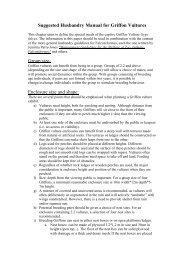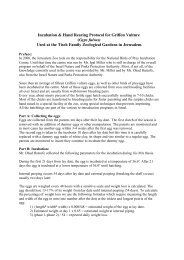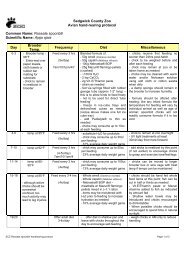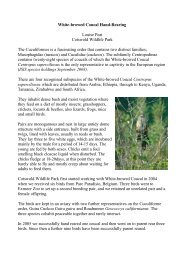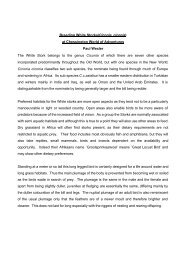SCZ Black crake chick Handrearing protocol Page 1 of 3 Sedgwick ...
SCZ Black crake chick Handrearing protocol Page 1 of 3 Sedgwick ...
SCZ Black crake chick Handrearing protocol Page 1 of 3 Sedgwick ...
Create successful ePaper yourself
Turn your PDF publications into a flip-book with our unique Google optimized e-Paper software.
Common Name: <strong>Black</strong> <strong>crake</strong><br />
Scientific Name: Amaurornis flavirostris<br />
<strong>Sedgwick</strong> County Zoo<br />
Avian hand-rearing <strong>protocol</strong><br />
Day Brooder Temp. Frequency Diet Miscellaneous<br />
0-3<br />
4-6<br />
7-10<br />
11-14<br />
15-18<br />
19/20<br />
- Brooder temp - 98°F<br />
- Rubber bar matting<br />
or Enka-mat® over<br />
paper towels for<br />
substrate<br />
- Feather duster may<br />
be added for <strong>chick</strong><br />
to hide under<br />
- Shallow water bowl<br />
provided<br />
- temp at 96°F<br />
- temp at 94°F<br />
- temp at 92°F<br />
- temp at 90°F<br />
- move to wire cage<br />
or small flight cage<br />
from brooder –<br />
supplemental heat if<br />
necessary; temp<br />
between 85-88°F<br />
Feed every<br />
2 hrs<br />
(7-8x/day)<br />
Feed every<br />
2 hrs<br />
(5-6x/day)<br />
Feed every<br />
3 hrs<br />
(4-5x/day)<br />
Fresh diet<br />
<strong>of</strong>fered<br />
3x/day<br />
Fresh diet<br />
<strong>of</strong>fered<br />
2x/day<br />
- soaked Mazuri® Parrot<br />
pellets<br />
- finely chopped mouse pinks<br />
- food moistened w/ H20<br />
- <strong>chick</strong> may consume between<br />
0.1 – 0.5 g/feeding<br />
- Daily weight gains average<br />
4.7% during this stage<br />
- mouse pinks may be cut into<br />
larger pieces<br />
- <strong>chick</strong> may consume up to<br />
0.3 – 1.0 g/feeding<br />
- Daily weight gains average<br />
11.6% during this stage<br />
- begin leaving food in brooder<br />
between feedings<br />
- Daily weight gains average<br />
13.0% during this stage<br />
- <strong>of</strong>fer adult diet:<br />
- <strong>SCZ</strong> Galliforme mix<br />
- w/ chopped pinks<br />
- Daily weight gains average<br />
10.9% during this stage<br />
- discontinue chopped pinks in<br />
diet<br />
- Daily weight gains average<br />
7.0% during this stage<br />
- begin <strong>of</strong>fering insects as<br />
indicated by adult diet<br />
- Daily weight gains average<br />
5.9% during this stage<br />
- <strong>of</strong>fer food with forceps<br />
- for single <strong>chick</strong>s: hold <strong>chick</strong> in<br />
one hand – encircling body so<br />
just the head protrudes<br />
between hole made with thumb<br />
and pointer finger<br />
- for more than one <strong>chick</strong>: place<br />
food tray in brooder and feed<br />
<strong>chick</strong>s at the same time (no<br />
need to handle them); <strong>chick</strong>s<br />
will be encouraged to feed<br />
while watching each other.<br />
- <strong>chick</strong> to be weighed before and<br />
after each feeding<br />
- <strong>chick</strong> may remain at zoo<br />
overnight<br />
- <strong>chick</strong> to remain at zoo overnight<br />
- continue to <strong>of</strong>fer food with<br />
forceps<br />
- larger water bowl may be<br />
introduced<br />
- <strong>chick</strong> should be picking up food<br />
on occasion without assistance<br />
- continue to <strong>of</strong>fer food with<br />
forceps<br />
- weigh <strong>chick</strong> only in AM<br />
- <strong>chick</strong> should be self-feeding<br />
without any prompting when<br />
food is <strong>of</strong>fered<br />
- remove feather duster and <strong>of</strong>fer<br />
artificial plants for cover<br />
<strong>SCZ</strong> <strong>Black</strong> <strong>crake</strong> <strong>chick</strong> <strong>Handrearing</strong> <strong>protocol</strong> <strong>Page</strong> 1 <strong>of</strong> 3
Adult diet for 0.0.1 black <strong>crake</strong> at <strong>SCZ</strong>:<br />
Common<br />
name<br />
Scientific<br />
name<br />
Ingredient form fed Quantity <strong>of</strong>fered Quantity <strong>of</strong>fered Frequency<br />
by Volume by weight (g) <strong>of</strong>fered<br />
<strong>Black</strong> <strong>crake</strong> Galliforme<br />
mix<br />
- 2 Tblsp 18g AM/PM<br />
Limnocorax reg. whole 3 0.21g AM/PM<br />
flavirostra Mealworms<br />
‘Galliforme’ diets:<br />
Ground dwelling birds such as turkeys, guineafowl, pheasants, curassows, tinamou etc receive a<br />
galliforme mix.<br />
Galliforme mix : 2 parts : Mazuri® Exotic Gamebird pellets<br />
1 part : Scenic® Tropical Bits pellets<br />
1 part : soaked Mazuri® parrot pellets<br />
½ part : chopped hard boiled egg<br />
1 part : chopped romaine lettuce<br />
1 part : Passerine fruit: apples<br />
(finely chopped) banana<br />
steamed yam<br />
melon<br />
papaya<br />
grapes<br />
It is accepted that the weight <strong>of</strong> individually portioned amounts (tablespoons, cups, etc) can vary<br />
due to the mix itself and the preparer <strong>of</strong> the diet. Therefore the following weights will be used when<br />
assessing diets that use the Galliforme mix:<br />
1 Tablespoon: 9g<br />
¼ cup: 36g<br />
½ cup: 72g<br />
1 cup: 144g<br />
The pellets <strong>of</strong>fered will be rotated on the schedule below:<br />
March 1 st – Sept. 1 st : Mazuri® Exotic Gamebird Breeder<br />
Sept 1 st – March 1 st : Mazuri® Exotic Gamebird Maintenance<br />
<strong>SCZ</strong> <strong>Black</strong> <strong>crake</strong> <strong>chick</strong> <strong>Handrearing</strong> <strong>protocol</strong> <strong>Page</strong> 2 <strong>of</strong> 3
Products mentioned in <strong>protocol</strong><br />
Portable brooders – Various brands and sizes <strong>of</strong> portable brooders have been used over the<br />
years. The typical format is a modified food/beverage transport cooler with thermostat controls.<br />
This style is almost always accessed through a clear Plexiglas top and is preferred for rearing<br />
altricial species. In addition these units are able to be transported in a vehicle – drawing power to<br />
continue temperature control from the cigarette lighter/auxiliary power port.<br />
http://www.aveyincubator.com/ and http://www.petiatric.com/nurseryhospitalbrooders.aspx<br />
Enkamat - Enkamat is the name <strong>of</strong> a product family <strong>of</strong> permanent erosion protection mats<br />
made <strong>of</strong> mon<strong>of</strong>ilaments fused together where they cross. All Enkamat products are based on a<br />
proven flexible three-dimensional open structure.<br />
http://www.colbondgeosynthetics.com/cms/generated/pages/products/enkamat/productfamily/default.htm<br />
Mazuri® Parrot diets:<br />
http://shop.mazuri.com/psittacinepasserinediets.aspx<br />
Scenic® Tropical Bits pellets - Tropical Bits multi-colored, mini-pellet size (about 1mm) food<br />
adapts to a wide variety <strong>of</strong> feeding <strong>protocol</strong>s for omnivore, insectivore, and frugivore birds.<br />
http://www.scenicbirdfood.com/products/tropical-bits-food/161/tropical-bits<br />
Textured Vegetable Protein - TVP is a food product made from soybeans. It is produced from soy<br />
flour after the soybean oil has been extracted, then cooked under pressure, extruded, and dried.<br />
TVP® has a long shelf life if stored properly and is an excellent source <strong>of</strong> protein and fiber. Plain<br />
TVP® has zero cholesterol.<br />
<strong>SCZ</strong> <strong>Black</strong> <strong>crake</strong> <strong>chick</strong> <strong>Handrearing</strong> <strong>protocol</strong> <strong>Page</strong> 3 <strong>of</strong> 3



